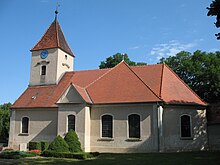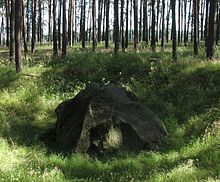Krahne
|
Krahne
Lehnin monastery community
Coordinates: 52 ° 19 ′ 14 ″ N , 12 ° 33 ′ 46 ″ E
|
|
|---|---|
| Height : | 39 m |
| Residents : | 565 (2012) |
| Incorporation : | April 1, 2002 |
| Postal code : | 14797 |
| Area code : | 033835 |
|
Manor house in Krahne
|
|
Krahne is a district of the municipality of Kloster Lehnin in the west of the state of Brandenburg , about twelve kilometers south of the city of Brandenburg an der Havel .
geography
Krahne is located south of the city of Brandenburg an der Havel in the valley of the Plane . The originally geographical term Zauche is hardly used anymore, the assignment to Havelland , which is often found, is incorrect. The Krahner Busch , a forest area and nature reserve, is located west of the village. On the western edge of the Krahne district, parts of it extend into the Free Havelbruch .
Krahne borders on Reckahn (since 2002 district of Kloster Lehnin ) and Göttin (since 1993 district of Brandenburg an der Havel ), in the east on Prützke (since 2002 district of Kloster Lehnin ), in the south on the community of Golzow and in the west the municipality of Wollin .
History and etymology
Krahne was first mentioned - albeit indirectly - in a document dated July 25, 1230. In this document, Bishop Gernand von Brandenburg gave the monastery Lehnin the collection of tithe in the village of Derwitz . A man named Albert from Krahne was called as a witness for this donation. This document no longer exists in the 21st century. In the Potsdam State Archives , however, there is a copy from 1442. The name is derived from the Slavic and was attributed by experts to the word kora , which means something like bark or crust. The spelling changed over the centuries from Korans, Chorans, Corans, Corans, Cronne, Crane, Krone, Krane to Krahne. Experts suspect that the Slavic settlement took place below the still existing town center. A field name Alte Höfe has been handed down there in the 21st century . Not much is known about the further history of the place. It was not until 1575 that Krahne appeared in a visit in which the farmers were obliged to attend the church service . Another mention comes from the year 1600 in a register .
Krahne had been a large farming village for centuries and belonged to the von Rochow family , Reckahner Linie. Under her church patronage , craftsmen built a village church in 1767 , possibly using a previous building. In 1779 Friedrich Eberhard von Rochow had a village school built based on the model of his school in Reckahn. From 1808 to 1814 the preacher and schoolman Friedrich Wilhelm Gotthilf Frosch worked here, who founded the first Brandenburg School Teachers' Conference here in 1810 and a little later a school teacher seminar to train new elementary school teachers. As the seat of the parish, it will be the core of the parish district of the villages of Krahne, Reckahn and Göttin until the 21st century. In 1813 there was a major fire in the village, in which the church was also badly damaged. Craftsmen repaired it, but in 1904 the church patron decided to fundamentally renovate it. The manor house was built in 1898 and the train station in 1904. A men's choir was founded in the 1920s and existed until the 1930s. In 1928 the Rotscherlinde Vorwerk was incorporated into Krahne.
After the end of the Second World War , numerous settlement houses were built on Lindenweg and Akazienweg. In 1948 and 1949, Krahne was connected to a central water supply. 1958 founded an LPG On April 1st, 2002 Krahne became part of the large community of Kloster Lehnin.
Mayor
The honorary mayor is Reinhard Siegel (district farmers' associations BV-BB).
Culture and sights
- The Krahne village church is a neo-baroque hall church that was expanded in a cross shape in 1904 under the direction of the architect Ludwig von Tiedemann .
- Rectory from 1743
- Manor house with (overgrown) park
- Krahner Busch nature reserve
- The blue stone is a large boulder with a bluish-green color in the forest about two kilometers east of the village. This was previously used as a quarry . The legend of the Blue Stone has grown up around the boulder: in earlier times giants ruled the Briesen mountains. They got furious when the Krahn residents started building a church tower . They hurled a field stone at the structure, but it missed its target. The stone hit a wooded area and tore a deep hole in the earth. Its blue color attracted numerous people who broke off parts of the stone and used it as building material.
- The partner community of Marborn designed the centrally located Marborner Platz . The home community of the Brothers Grimm placed seven stone pillars around a larger stone, reminiscent of the fairy tale of Snow White . The square was inaugurated on September 10, 2007.
- To the northeast of the village center, a boulder commemorates the forester Hermann Joseph Paul Illmann. He was shot by poachers in 1908. The story came to be known as the Krahne Bloody Drama .
Personalities associated with Krahne
- Friedrich Eberhard von Rochow (1734–1805), landowner of the Krahne manor, school reformer, founder of the school
- Friedrich Wilhelm Gotthilf Frosch (1776–1834), pastor and school reformer, founded and managed institutions for teacher training in the village
- Christian Friedrich Cunow (1648–1706), hymn poet and temporarily Protestant pastor in Krahne
literature
- Gerke Pachali 1230–1980 | 750 years of Krahne , April 1980
Web links
Individual evidence
- ↑ Müller's Large German Local Book 2012: Complete local dictionary. 33. revised and exp. Ed., Walter de Gruyter, Berlin and Boston 2012, ISBN 978-3-11-027420-2 , online at Google Books , p. 762
- ↑ BrandenburgViewer of the state survey and geographic base information Brandenburg (LGB)
- ↑ StBA: Changes in the municipalities in Germany, see 2002
- ↑ Information panel The Sage of the Blue Stone , north of the church, May 2019.
- ↑ Information board : Memorial for Forester Illmann , set up next to the boulder, May 2019.


